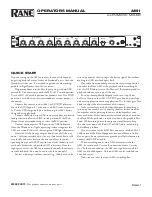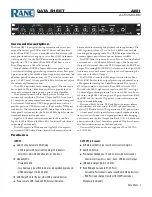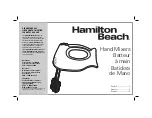
Compressor Types
15
THRESHOLD
—This determines the input signal level at
which compression and expansion are applied. Signals at
a level below the sum of the threshold and width are
attenuated by the expander. Signals at and above the
threshold level are compressed by the amount specified
using the Ratio parameter. The trigger signal is sourced
using the KEY IN parameter.
OUT GAIN
—This sets the compander’s output signal
level. It can be used to compensate for the overall level
change caused by the compression and expansion pro-
cesses.
WIDTH
—This determines how far below the threshold
level expansion is applied. The expander is essentially
turned off when the width is set to 90 dB.
ATTACK
—Specifies the time over which the signal will
be compressed (starting when the compressor of the
compander is triggered) or the time over which the gain
will return to normal after the expander is triggered. If
the attack time is fast, the signal will be compressed or
return to normal nearly instantaneously. If the attack
time is slow, the initial attack portion of the sound will
not be compressed or return to normal. Attack times
from 1 to 5 milliseconds are a good place to start.
RELEASE
—Specifies the time from when the level of
the trigger signal falls below the threshold until the com-
pressor returns to the normal gain or the expander
expands. If the release time is too short, the compressor
gain will return suddenly, making the sound jump out
(i.e., the gain will change unnaturally). However if the
release is too long, the next high-level signal will be
input before the compressor gain has returned, and
compression may not occur appropriately. Release times
from 0.1 to 0.5 seconds are a good place to start.
RATIO
—This determines the amount of compression.
That is, the change in output signal level relative to
change in input signal level. For a 2:1 ratio, for example,
a 10 dB change in input level (above the threshold)
results in a 5 dB change in output level. For a 5:1 ratio, a
10 dB change in input level (above the threshold) results
in a 2 dB change in output level. The expander ratios are
fixed: 1.5:1 for the soft compander (S) and 5:1 for the
hard compander (H).
INPUT FILTER HPF/LPF
—Select the filter that will be
applied to the signal immediately before the expander.
When HPF (high pass filter) is on, the expander will
apply to the signal that has passed through the HPF, and
the signal that has passed through the LPF will then be
mixed in.
When LPF (low pass filter) is on, the expander will apply
to the signal that has passed through the LPF, and the
signal that has passed through the HPF will then be
mixed in.
If you want the signal immediately after passing
through the LPF or HPF to be used as the key-in
signal for the internal compressor, select SELF
POST EQ as the key-in signal.
When the key-in signal is set to LEFT CH (when
the key-in signal is taken from the previous-num-
bered channel), and if COMP is turned on and LPF
or HPF is also turned on for the channel that is the
source of the key-in signal, then the signal after
passing through the filter will be output as the key-
in signal.
INPUT FILTER ON/OFF
—This turns the input filter on/
off. If off, the LPF/HPF setting will be ignored.
INPUT FILTER FREQUENCY
—This sets the cutoff fre-
quency of the LPF/HPF. (The LPF cutoff frequency and
HPF cutoff frequency are always linked.)
Parameter
Range
THRESHOLD
–54 dB to 0 dB (1 dB steps)
OUT GAIN
–18 dB to ±0.0 dB (0.5 dB steps)
WIDTH
1 dB–90 dB (1 dB steps)
ATTACK
0–120 ms (1 ms steps)
RELEASE
5 ms–42.3 s (fs = 48 kHz)
6 ms–46 s (fs = 44.1 kHz)
RATIO
1:1, 1.1:1, 1.3:1, 1.5:1, 1.7:1, 2:1,
2.5:1, 3:1, 3.5:1, 4:1, 5:1, 6:1, 8:1,
10:1, 20:1 (15 points)
INPUT FILTER
HPF/LPF
HPF (high-pass filter) or
LPF (low-pass filter)
INPUT FILTER
ON/OFF
ON or OFF
INPUT FILTER
FREQUENCY
20 Hz–20 kHz (121 steps)
SELF POST EQ
For COMP ON and HPF ON
LPF
HPF
+
COMPANDER H/S
For COMP ON and LPF ON
HPF
LPF
+
COMPANDER H/S
SELF POST EQ
Содержание CS1D
Страница 1: ...Owner s Manual ...
Страница 5: ...Operating Manual ...
Страница 6: ...Operating Manual Start up ...
Страница 55: ...Operating Manual Basic Operation ...
Страница 214: ...Reference Manual ...
Страница 215: ...Reference Manual Hardware ...
Страница 332: ...Reference Manual Software ...
Страница 530: ...Reference Manual Appendices ...
















































